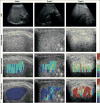A Pilot Comparative Study of Quantitative Ultrasound, Conventional Ultrasound, and MRI for Predicting Histology-Determined Steatosis Grade in Adult Nonalcoholic Fatty Liver Disease
- PMID: 28267360
- PMCID: PMC5512552
- DOI: 10.2214/AJR.16.16726
A Pilot Comparative Study of Quantitative Ultrasound, Conventional Ultrasound, and MRI for Predicting Histology-Determined Steatosis Grade in Adult Nonalcoholic Fatty Liver Disease
Abstract
Objective: The purpose of this study is to explore the diagnostic performance of two investigational quantitative ultrasound (QUS) parameters, attenuation coefficient and backscatter coefficient, in comparison with conventional ultrasound (CUS) and MRI-estimated proton density fat fraction (PDFF) for predicting histology-confirmed steatosis grade in adults with nonalcoholic fatty liver disease (NAFLD).
Subjects and methods: In this prospectively designed pilot study, 61 adults with histology-confirmed NAFLD were enrolled from September 2012 to February 2014. Subjects underwent QUS, CUS, and MRI examinations within 100 days of clinical-care liver biopsy. QUS parameters (attenuation coefficient and backscatter coefficient) were estimated using a reference phantom technique by two analysts independently. Three-point ordinal CUS scores intended to predict steatosis grade (1, 2, or 3) were generated independently by two radiologists on the basis of QUS features. PDFF was estimated using an advanced chemical shift-based MRI technique. Using histologic examination as the reference standard, ROC analysis was performed. Optimal attenuation coefficient, backscatter coefficient, and PDFF cutoff thresholds were identified, and the accuracy of attenuation coefficient, backscatter coefficient, PDFF, and CUS to predict steatosis grade was determined. Interobserver agreement for attenuation coefficient, backscatter coefficient, and CUS was analyzed.
Results: CUS had 51.7% grading accuracy. The raw and cross-validated steatosis grading accuracies were 61.7% and 55.0%, respectively, for attenuation coefficient, 68.3% and 68.3% for backscatter coefficient, and 76.7% and 71.3% for MRI-estimated PDFF. Interobserver agreements were 53.3% for CUS (κ = 0.61), 90.0% for attenuation coefficient (κ = 0.87), and 71.7% for backscatter coefficient (κ = 0.82) (p < 0.0001 for all).
Conclusion: Preliminary observations suggest that QUS parameters may be more accurate and provide higher interobserver agreement than CUS for predicting hepatic steatosis grade in patients with NAFLD.
Keywords: attenuation; backscatter; grading accuracy; interobserver agreement; nonalcoholic fatty liver disease; nonalcoholic steatohepatitis; proton density fat fraction; quantitative imaging biomarkers; quantitative ultrasound.
Figures




Similar articles
-
Noninvasive Diagnosis of Nonalcoholic Fatty Liver Disease and Quantification of Liver Fat Using a New Quantitative Ultrasound Technique.Clin Gastroenterol Hepatol. 2015 Jul;13(7):1337-1345.e6. doi: 10.1016/j.cgh.2014.11.027. Epub 2014 Dec 3. Clin Gastroenterol Hepatol. 2015. PMID: 25478922 Free PMC article.
-
Novel Method for Ultrasound-Derived Fat Fraction Using an Integrated Phantom.J Ultrasound Med. 2020 Dec;39(12):2427-2438. doi: 10.1002/jum.15364. Epub 2020 Jun 11. J Ultrasound Med. 2020. PMID: 32525261
-
Diagnostic Performance of 9 Quantitative Ultrasound Parameters for Detection and Classification of Hepatic Steatosis in Nonalcoholic Fatty Liver Disease.Invest Radiol. 2022 Jan 1;57(1):23-32. doi: 10.1097/RLI.0000000000000797. Invest Radiol. 2022. PMID: 34049335
-
A meta-analysis on the diagnostic performance of magnetic resonance imaging and transient elastography in nonalcoholic fatty liver disease.Eur J Clin Invest. 2021 Feb;51(2):e13446. doi: 10.1111/eci.13446. Epub 2020 Dec 9. Eur J Clin Invest. 2021. PMID: 33128454
-
Noninvasive monitoring of hepatic steatosis: controlled attenuation parameter and magnetic resonance imaging-proton density fat fraction in patients with nonalcoholic fatty liver disease.Expert Rev Gastroenterol Hepatol. 2019 Jun;13(6):523-530. doi: 10.1080/17474124.2019.1608820. Epub 2019 Apr 25. Expert Rev Gastroenterol Hepatol. 2019. PMID: 31018719 Review.
Cited by
-
Ultrasound-Based Attenuation Imaging for the Non-Invasive Quantification of Liver Fat - A Pilot Study on Feasibility and Inter-Observer Variability.IEEE J Transl Eng Health Med. 2020 Jun 10;8:1800409. doi: 10.1109/JTEHM.2020.3001488. eCollection 2020. IEEE J Transl Eng Health Med. 2020. PMID: 32617199 Free PMC article.
-
Quantification of Liver Fat Content With Unenhanced MDCT: Phantom and Clinical Correlation With MRI Proton Density Fat Fraction.AJR Am J Roentgenol. 2018 Sep;211(3):W151-W157. doi: 10.2214/AJR.17.19391. Epub 2018 Jul 17. AJR Am J Roentgenol. 2018. PMID: 30016142 Free PMC article.
-
Diagnostic Performance Comparison Between Ultrasound Attenuation Measurements From Right and Left Hepatic Lobes for Steatosis Detection in Non-alcoholic Fatty Liver Disease.Acad Radiol. 2023 Sep;30(9):1838-1845. doi: 10.1016/j.acra.2022.12.025. Epub 2022 Dec 29. Acad Radiol. 2023. PMID: 36586759 Free PMC article.
-
Quantitative Hepatic Fat Quantification in Non-alcoholic Fatty Liver Disease Using Ultrasound-Based Techniques: A Review of Literature and Their Diagnostic Performance.Ultrasound Med Biol. 2018 Dec;44(12):2461-2475. doi: 10.1016/j.ultrasmedbio.2018.07.019. Epub 2018 Sep 16. Ultrasound Med Biol. 2018. PMID: 30232020 Free PMC article. Review.
-
Non-invasive diagnosis: non-alcoholic fatty liver disease and alcoholic liver disease.Transl Gastroenterol Hepatol. 2020 Apr 5;5:31. doi: 10.21037/tgh.2019.11.14. eCollection 2020. Transl Gastroenterol Hepatol. 2020. PMID: 32258535 Free PMC article. Review.
References
Publication types
MeSH terms
Grants and funding
LinkOut - more resources
Full Text Sources
Other Literature Sources
Medical

